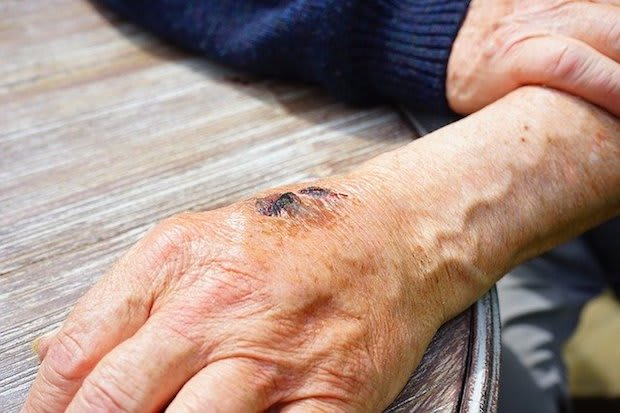Table of Contents
IV. Medications for Blood Clots
What are Blood Clots?
Blood continuously circulates the body throughout your entire life, supplying your system with essential vitamins and nutrients. The amount of blood in the body depends on your size. A newborn baby’s body contains around a cup of blood, whereas an adult weighing 150-180 pounds can have 1.2-1.5 gallons of blood. [1]
Blood carries cells and antibodies to fight infection, and it can clot to prevent excessive blood loss. Because it is constantly in motion, there is always a chance that the blood may clot improperly and lead to dangerous complications. Normally, a clot occurs when the skin experiences an external injury and bleeding occurs. This process involves:
- Blood platelets form a plug, which is released when a blood vessel is damaged. They stick to the walls and form a shape to fill the vessel's broken part to staunch the bleeding.
- The blood clot grows and becomes much tougher and more durable.
- At this point, the clotting process stops its growth, so the clot does not get larger than necessary.
- The clot slowly breaks down as the tissue heals, and the clot isn’t needed anymore.
Waxy cholesterol plaques in the arteries may break open and trigger the clotting process. This type of clot may result in heart attacks or strokes. Clots may also form if the blood does not flow properly and pools in the blood vessels or heart. Atrial fibrillation and deep vein thrombosis can occur due to slow-moving blood. [2] Read on to learn more about blood clots and medications that may prevent blood clots, including Coumadin (warfarin), Elmiron (pentosan polysulfate sodium), Eliquis (apixaban), and Aggrenox (dipyridamole + ASA). Arterial blood clots: This type of blood clot develops in an artery. It can be dangerous and obstruct blood flow to the heart or brain. Arterial blood clots can also narrow arteries and cause muscle pain (angina). Symptoms of these clots depend on where the clot is formed. People who have atherosclerosis are at risk of this disorder, which occurs when fatty deposits build on the walls. [3] Venous clots: Venous clots are formed in veins and are caused by slowed blood flow to the legs and feet. They may occur when there is damage to the veins due to injury or infection. A sedentary lifestyle is usually the culprit of venous clots. Those who are confined to a bed or do not participate in much physical activity are more likely to suffer clots. Sitting for a long time on a plane may also cause venous clots. [4] Symptoms of blood clots vary depending on where the clot occurs in the body. Learn more about area-specific symptoms below. Around 60 percent of people with blood clots in the arm may not experience any symptoms. Symptoms usually come on slowly, and you should look out for the following signs: Legs are often a common location for blood clots and may become dangerous if they travel up to the lungs. Look out for the following symptoms of leg blood clots: A blood clot in the heart may have similar symptoms to a heart attack, including: A blood clot in the lungs is also known as a pulmonary embolism. The most common symptoms include: Blood clots in the brain may form when fatty deposits build up in the blood vessels that bring blood to the brain. They may also form due to head injuries or when clots travel to the lungs from other parts of the body. Symptoms may include: Abdominal blood clots may occur due to undiagnosed cancer in the liver or pancreas. They may also form after surgery on the abdomen or if you have cirrhosis. Symptoms of abdominal blood clots include: Suffering a blood clot is a worry for many people because its symptoms may be overlooked. If you have previous health conditions like heart problems, you may be prescribed preventative blood-thinning medications. If you suffer from one blood clot, you will most likely also be prescribed blood thinners like Coumadin (warfarin), Elmiron (pentosan polysulfate sodium), Eliquis (apixaban), and Aggrenox (dipyridamole + ASA). The types of blood thinners include: Unfractionated heparin (UFH): This fast-acting blood thinner works with antithrombin (a natural protein in the body) to block clot formation. It also inhibits the body's potent clotting factors (factor Xa and factor Ila). Low molecular weight heparin (LMWH): This type is derived from UFH but lasts longer and acts more predictably in the body. It inhibits clotting factors and does not require as much blood monitoring. Warfarin: This drug works by inhibiting the liver’s ability to make coagulation proteins that require vitamin K for their synthesis. Doses for warfarin are contingent on the individual and require regular monitoring. Direct oral anticoagulants (DOACS): These are short-acting agents that come with a low risk of excessive bleeding. They block a single clotting factor to prevent clots and may require less blood monitoring. Blood thinners are some of the most common medications prescribed, so talk to your doctor to discuss the right blood-thinning medication for you. The content in this article is intended for informational purposes only. This website does not provide medical advice. In all circumstances, you should always seek the advice of your physician and/or other qualified health professionals(s) for drug, medical condition, or treatment advice. The content provided on this website is not a substitute for professional medical advice, diagnosis, or treatment.
Types of Blood Clots
Symptoms of Blood Clots
a. Arms and Legs

b. Heart and Lungs
c. Brain

d. Abdomen
Medications for Blood Clots
